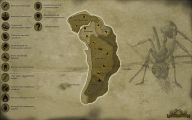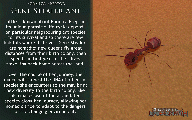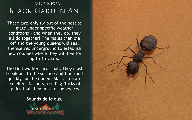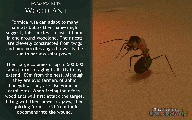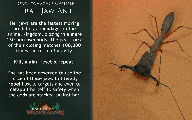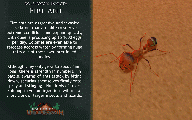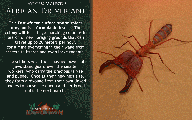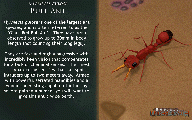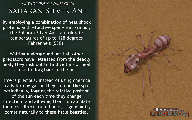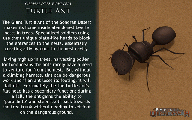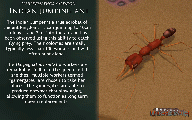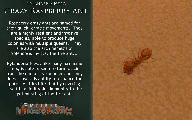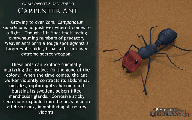Kickstarter Concept: Difference between revisions
(Created page with "This page shows the early concepts of '''Empires of the Undergrowth''' from 2015 to 2017. Most of these concepts have been removed or changed. <br/> =='''History'''== '''Empires of the Undergrowth''' was planned to be a tug-of-war game on mobile phone. The developers tried to create the game using their own homemade engine. The original story of the game involved a scientist who followed a ''Formica ereptor'' queen on its migration. The story occured on an island with...") |
No edit summary |
||
| Line 19: | Line 19: | ||
The game was strictly about two colonies fighting against each other and controling territories. The maps could be split into many zones. You must send your soldiers to patrol certain zones and took control of it. The more soldiers you had, the faster it got. When your territory and enemy territory collided, you could set your soldiers to attack the enemy colony. You could claim enemy territories the more you advanced. | The game was strictly about two colonies fighting against each other and controling territories. The maps could be split into many zones. You must send your soldiers to patrol certain zones and took control of it. The more soldiers you had, the faster it got. When your territory and enemy territory collided, you could set your soldiers to attack the enemy colony. You could claim enemy territories the more you advanced. | ||
Titans guarded some territory zones. They had to be killed for you to take control of the areas. Titan beetles, [[Emperor Scorpion|emperor scorpions and huge [[Hermit Crab|hermit crabs]] were planned to be in the game. | Titans guarded some territory zones. They had to be killed for you to take control of the areas. Titan beetles, [[Emperor Scorpion|emperor scorpions]] and huge [[Hermit Crab|hermit crabs]] were planned to be in the game. | ||
There were hills and elevation on the surface. Ants could climb up cliffs. | There were hills and elevation on the surface. Ants could climb up cliffs. | ||
| Line 27: | Line 27: | ||
<br/> | <br/> | ||
=='''Playable units'''== | =='''Playable units'''== | ||
You had to play as the local ant species first when you got to a new area to learn about them. You would play against a gene-thief ant colony in these | You had to play as the local ant species first when you got to a new area to learn about them. You would play against a gene-thief ant colony in these levels and observe its progress. | ||
You could play as gene-thief ants for the other half of the game. You gained access to more units as you continued | You could play as gene-thief ants for the other half of the game. You gained access to more units as you continued the story. You should lose all resources and most of your ants when you moved to a new area. | ||
12 species were made as concept arts without any actual planning. | 12 species were made as concept arts without any actual planning. | ||
| Line 57: | Line 57: | ||
<br/> | <br/> | ||
=='''Concept arts'''== | =='''Concept arts'''== | ||
<gallery widths= | <gallery widths=200px> | ||
File:Concept Island. | File:Concept Island.jpg|Mysterious island | ||
File:Concept Genethief.gif| | File:Concept Genethief.gif|Gene-thief ant | ||
File:Concept Black.gif| | File:Concept Black.gif|Black garden ant | ||
File:Concept Slavemaker.gif| | File:Concept Slavemaker.gif|Slave-maker ant | ||
File:Concept Wood.gif| | File:Concept Wood.gif|Wood ant | ||
File:Concept Leafcutter.gif| | File:Concept Leafcutter.gif|Leafcutter ant | ||
File:Concept Trapjaw.gif| | File:Concept Trapjaw.gif|Trap-jaw ant | ||
File:Concept Fire.gif| | File:Concept Fire.gif|Fire ant | ||
File:Concept Driver.gif| | File:Concept Driver.gif|Driver ant | ||
File:Concept Bull.gif| | File:Concept Bull.gif|Bull ant | ||
File:Concept Silver.gif| | File:Concept Silver.gif|African silver ant | ||
File: | File:Concept Turtle.gif|Turtle ant | ||
File:Concept Jumping.gif| | File:Concept Jumping.gif|Indian jumping ant | ||
File:Concept Honeypot.gif| | File:Concept Honeypot.gif|Honeypot ant | ||
File:Concept Rasberry.gif| | File:Concept Rasberry.gif|Rasberry crazy ant | ||
File:Concept Carpenter.gif| | File:Concept Carpenter.gif|Exploding carpenter ant | ||
</gallery> | </gallery> | ||
<br/> | <br/> | ||
[[Category:Miscellaneous]] | [[Category:Miscellaneous]] | ||
Revision as of 11:32, 17 June 2024
This page shows the early concepts of Empires of the Undergrowth from 2015 to 2017. Most of these concepts have been removed or changed.
History
Empires of the Undergrowth was planned to be a tug-of-war game on mobile phone. The developers tried to create the game using their own homemade engine.
The original story of the game involved a scientist who followed a Formica ereptor queen on its migration. The story occured on an island with a variety of environments and ant species that shouldn't exist in the same place. The gene-thief ant colony expanded through the island, killing rival ant colonies and gaining their desirable traits. The missions would be narrated in a documentary style.
The first kickstarter campaign failed. Most backers were more interested in playing the game on PC. Building their own engine for mobile also proved to be too time consuming and constricting. Therefore, the developers changed the game into a real-time-strategy PC game and built it using Unreal Engine 4.
Mechanics
The mechanics for digging, building, spawning, gathering and attacking were generally the same as the current ones. Tapping anywhere on the screen made the building tabs pop up. Digging had to be selected from the building tabs.
Pheromone groups didn't actually exist. You must tap on a brood chamber, then tap on the designated targets to make the selected group of ants do its tasks. Workers could only harvest. You could only assign tasks within your territory.
Ants move toward the enemy nest when they are assigned to battle. If you disabled attacking, they retreated back to the queen. Soldiers could both harvest and combat.
The game was strictly about two colonies fighting against each other and controling territories. The maps could be split into many zones. You must send your soldiers to patrol certain zones and took control of it. The more soldiers you had, the faster it got. When your territory and enemy territory collided, you could set your soldiers to attack the enemy colony. You could claim enemy territories the more you advanced.
Titans guarded some territory zones. They had to be killed for you to take control of the areas. Titan beetles, emperor scorpions and huge hermit crabs were planned to be in the game.
There were hills and elevation on the surface. Ants could climb up cliffs.
There was a plan for map editor.
Playable units
You had to play as the local ant species first when you got to a new area to learn about them. You would play against a gene-thief ant colony in these levels and observe its progress.
You could play as gene-thief ants for the other half of the game. You gained access to more units as you continued the story. You should lose all resources and most of your ants when you moved to a new area.
12 species were made as concept arts without any actual planning.
- Black ants (Lasius niger) could harvest honeydew from aphids more efficiently. They could be upgraded to cost less.
- Slave-maker ants (Polyergus lucidus) could steal enemy larvae.
- Wood ants (Formica rufa) could shoot acid from a distance.
- Leafcutter ants (Atta cephalotes) could harvest leaves more efficiently. They had high health and could attract attention of enemies. They could either have higher physical resistance or higher venom resistance.
- Fire ants (Solenopsis invicta) could be summoned on command and disappeared after a short time. They could be either frail but strong or tanky but weak.
- Trap-jaw ants (Odontomachus chelifer) could occasionally stun enemies. They could fling themselves out of battle at low health to heal or they could fling enemies away, dealing extra damage.
- Driver ants (Dorylus molestus) were slow but strong. They could knock multiple enemies back at once or they could charge through the enemies, reshaping the frontline.
- Honeypot ants (Camponotus inflatus) could revive dead ants or increase attack speed of nearby allies.
- Carpenter ants (Camponotus saundersi) could explode and deal massive damage.
Trivia
- Black garden ants (Lasius niger) were replaced with black silky ants (Formica fusca) because the later are hosts of the chosen slave-maker ants (Formica sanguinea). They were removed from the game completely from version 0.05 onward.
Concept arts
 Hooded Horse Wikis
Hooded Horse Wikis